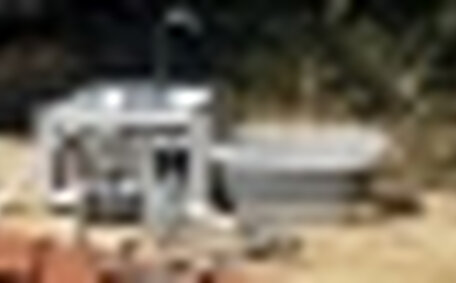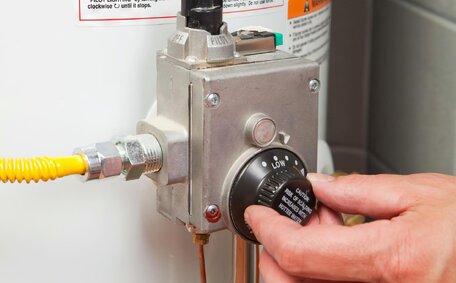Understanding Your Property’s Water System
The water system of your property begins at the main water line, connecting to the public supply. This primary line runs beneath your property to the water meter, often found in a box near the front boundary.
From the meter, the main water line distributes supplies to every plumbing fixture and device in your home. Crucial components for effectively managing the water flow in your home include:
- The inside stop valve - allows you to turn off all water inside the house. Located on an interior wall near the front entrance, basement or garage.
- Isolation valves - installed under sinks, behind toilets and near water-based appliances like washing machines and hot water systems. Allow you to turn off water to specific fixtures.
Being familiar with the locations of your home’s main shutoff and isolation valves, including the stop tap, prepares you for swift action to prevent potential water damage in case of emergencies.
Locating the Main Water Shutoff Valve
You’ll typically find the main shutoff valve on an interior wall by the front entrance, or within the basement, garage, or utility space. Examine the front exterior wall to locate the inside stop valve inside your home. Typical locations encompass:
- Adjacent to the water heater
- In proximity to the water meter or front hose bibs
- Inside a box or access panel labelled "water shutoff valve"
If locating the valve proves difficult, follow the main water line from the external meter into your home, checking boxes or panels along its path.
Whether it’s located inside or outside, it’s smart for all household members to know the exact location of the main shutoff valve, as advised by your local plumber. This knowledge enables anyone to promptly turn off the water in events such as a burst pipe or leak.
Identifying the Shutoff Valve Type
The two most common types of main water shutoff valves are ball valves and gate valves. Recognizing your valve type is crucial for proper operation.
Ball valves halt water flow when you rotate the lever a quarter turn to a position perpendicular to the pipe. Gate valves necessitate multiple clockwise turns of the wheel to gradually close and stop the water flow.
very happy with the water shut-off when needed.
Accessing the Valve
To turn off main water, start by clearing any items blocking access to the main water shutoff valve. This ensures you can turn off water main with ease in an emergency.
You may need specific tools to turn the valve, depending on the type:
- A ball valve requires a wrench or valve key to grip and turn the lever. Turn perpendicular to the pipe to shut off.
- A gate valve needs to be turned clockwise multiple rotations with a wrench. Turn until tight and water stops flowing.
Make sure the floor around the shut off valve is dry to prevent slips. Have someone support you if needed while turning the valve. Turn your water off slowly and smoothly.
Turning Off the Main Water Valve
When you need to turn off the main water valve, follow these safe procedures:
- Locate the valve and ensure the surrounding floor area is dry.
- Position yourself securely and have someone support you if needed.
- Use the proper tool to grip the valve - a wrench or valve key.
- Turn slowly and smoothly. Turn a ball valve a quarter turn so the lever is perpendicular to the pipe. Turn a gate valve clockwise multiple rotations until tight.
- A prudent approach is to initially shut off isolation valves, concluding with the main valve — a strategic sequence to reduce water flow. This allows water to drain from pipes.
- Once fully closed, check nearby faucets to ensure water flow has stopped. Opening a tap will relieve pressure and off main water to fully drain.
- To turn back on, reverse the process gradually and check for leaks.
To turn off your water main supply prevents further damage from occurring during a plumbing emergency like a burst pipe. If you have any difficulty shutting off water, call a professional plumber for assistance.
Releasing Water Pressure from the Pipes
After shutting off your mains water valve, it’s important to release any remaining water pressure in your plumbing system. This prevents pipes from bursting under pressure when the water supply is turned off.
Start by opening the faucets at the highest points in your house, like bathtub and shower faucets on upper floors. Then open taps at the lowest points, like basement sinks.
- Let the off valve run until it trickles to a stop. This indicates the pipes have drained.
- Keep all taps open until plumbing tasks are finished and the main valve has been reactivated. This ensures pipes stay free of pressure buildup.
Easing water pressure safeguards your system when the main water supply is deactivated, whether for repairs or in response to emergencies. Contact a professional plumber if you have any difficulties.
Turning Water Back On
When you have completed repairs or maintenance and are ready to restore water supply, carefully turn the main water valve back on by reversing the shut-off procedure:
- Notify household members that water is being turned back on.
- Ensure all faucets and fixtures are closed prior to restoring water flow.
- Use the proper tool to grip the main valve and turn it counter-clockwise (for a gate valve) or downward (for a ball valve) SLOWLY. Turn a little bit then check for leaks before continuing.
- Once the valve is fully open, check pipes, connections and fixtures throughout the house for any leaks.
- If there are no leaks after several minutes, slowly begin opening faucets one by one, starting with those at the lowest points in your home.
- Permit water to flow briefly to expel any air pockets within the pipes. Discoloured water is normal at first.
- Fully open all faucets once water runs clear.
- Check for leaks again and call a plumber immediately if found.
Reinstating your main water supply demands utmost caution to mitigate the risk of inflicting damage or causing a flood. If in doubt, contact a licenced plumber for assistance.
Inspecting for Leaks
Post-restoration of water flow, it’s essential to meticulously check your plumbing for any signs of leaks. Start by checking around the main water valve and supply lines for dripping. Signs of moisture or water damage may indicate past leaks.
Check all water-using fixtures and appliances throughout the house:
- Examine under sinks, behind toilets and near hot water systems for wetness
- Inspect the water metre, outdoor taps, pool equipment
- Look for drips or leaks near the dishwasher, washing machine, refrigerators and more
- Check the basement, garage and any exposed water lines
Be alert to any accumulation of water, changed colour, or dampness on walls and flooring. Running toilets, dripping faucets and moist pipe insulation can also indicate leaks. Diligently examine the entire network in the days that follow.
If any leaks are found, shut off the mains water supply to the problem area and call a plumber immediately.
Using Isolation Valves for Fixtures
Isolation valves are installed under sinks, behind toilets, and near washing machines, dishwashers and hot water systems. These valves allow you to shut off water supply to individual fixtures without affecting the rest of your plumbing system.
Deploying isolation valves when making repairs or during emergencies allows you to maintain water flow where needed, avoiding a full shutdown. This means you turn your water service to unaffected areas of your home.
It’s important to know the location of all isolation valves and ensure they are regularly operated to prevent seizing up. Try turning them at least twice a year. Call a plumber if you have difficulty operating any valve.
Familiarise all household members with isolation valve locations in case of emergencies when quick water shutoff is needed. This can help minimise water damage from leaks or bursts.
Emergency Protocols
It’s vital to have emergency protocols in place for quickly shutting off your water supply during urgent situations. This minimises flooding and water damage to your home.
The following are instances when promptly switching off the main water valve is critical:
- A burst water pipe or fitting
- A leaking gas hot water system or burst hot water pipe
- Major flooding inside or outside the home
- Preparing your home for an approaching storm, cyclone or flood
- Going away on holidays for an extended time
Create printed guides for pinpointing and manipulating your main water shutoff valve to confidently cease water flow. Keep copies near the valve and in emergency supply kits. Also indicate isolation valve locations on your emergency home plan.
Familiarise yourself with the water shut-off process by practising 2-3 times annually, ensuring swift action during stressful incidents. In an actual emergency, act quickly but carefully to avoid valve damage. Restoring water flow must also be done gradually and safely.
No matter the scenario, ensure safety is the priority when managing to supply your home’s needs or turning the water off. Never hesitate to call emergency services if you have any concerns about safely accessing or operating your homes water shutoff valves.
When to Call a Professional Plumber
While knowing how to shut off your main water supply during emergencies is crucial, some situations call for assistance from professional plumbers.
Reach out to Riverwood Plumbing’s licenced professionals or book an appointment should you encounter:
- An inability to locate or access the main water valve
- Difficulty operating a seized or damaged shutoff valve
- Major leaks, flooding or burst pipes causing water damage
- No water flow from taps after restoring supply
- Low water flow or pressure issues after turning water back on
- Signs of corrosion, cracks or leaks from the main water line
Our skilled plumbers possess the capability to examine your plumbing system, pinpoint problems, and execute repairs for optimal water flow and pressure.
Our reliable technicians, ready to assist around-the-clock, will address any issues related to water shutoff swiftly and thoroughly. Contact Riverwood Plumbing on 1300 349 338 or email [email protected].






